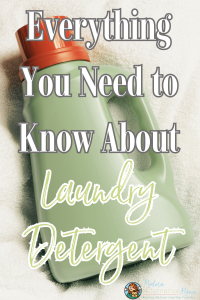By Sarena-Rae Santos, Natural Health Blogger
As someone very particular about the ingredients in products I use, I found it very suspicious when I realized most laundry detergents (and other cleaning supplies) didn’t list their ingredients on their bottles or websites. They expect you to use a third-party website to gather the ingredient information.
You’d think these companies would be proud of their products, but when you look at the ingredient lists, you will understand why they don’t disclose their ingredients directly on the packaging.
A while back, I was researching laundry detergent ingredients and came across an article featuring 12 mostly mainstream laundry detergents ranging between $0.12 and $0.57 per load. All I remember thinking is, what’s really in these top laundry detergents? What about the dangers associated with those ingredients? So I dug into it and am now sharing it with you.
Toxic Ingredients Found in Mainstream Laundry Detergent
There are so many gnarly ingredients in everyday products. This is not a complete list of ingredients to watch out for. I have a growing list of common ingredients to avoid in my blog, The Truth About Greenwashing.
Formaldehyde
Formaldehyde goes by several names, including Formalin, Formica Aldehyde, Methaldehyde, Methyl Aldehyde, Methylene Oxide, Methanal, Oxymethylene, Quaternium-15, Diazolidinyl Urea, DMDM Hydantoin, Imidazolidinyl Urea, 2-Bromo-2-Nitropropane-1,3-Diol, and Tris Nitromethane (1). Short-term exposure to formaldehyde has been linked to coughing, headaches, dizziness, nausea, eye, nose, and throat irritation, while long-term exposure to formaldehyde may cause certain types of cancer (2).
Fragrances
Fragrances are derived from petrochemicals. These chemicals include benzene derivatives, aldehydes, phthalates, and many other known toxins capable of causing cancer, congenital disabilities, nervous-system disorders, migraine attacks, asthma attacks, and allergies (3). Learn more in our blog, Everything You Need to Know About Fragrance.
SLS/SLES
Sodium Lauryl Sulfate & Sodium Laureth Sulfate/Sodium Lauryl Ether Sulfate (SLS/SLES) is the main ingredient in mainstream laundry detergents. Still, they’re also linked to skin, eye, and lung inflammation (4), along with internal organ damage (5), as well as acute skin and eye irritation (6). Additionally, the Environmental Working Group’s Skin Deep Cosmetic Safety Database considers SLS a “moderate hazard” and has been linked to endocrine disruption (7).
Phosphates
Phosphates refer to a wide variety of chemical compounds, including but not limited to; Orthophosphates, Pryophosphates, Polyphosphates, Sodium Tripolyphosphate (STPP), Tetrapotassoim Pyrophosphate (TKPP), Trisodium phosphates (TSP), Tetra-Sodium Pyrophosphates, Potassium Pyrophosphates, and Sodium Potassium Pyrophosphate (8). Phosphate exposure has been linked to cardiovascular disease, osteoporosis, and death (9). Additionally, phosphates are linked to endocrine disruption (10). If your health isn’t enough to convince you to make a switch, what about the aquatic life that suffers mineral poisoning that results in the death of many native marine animal species (11)?
Optical Brighteners/UV Brighteners
Although it doesn’t work well, optical Brighteners/UV Brighteners are what mainstream laundry detergent companies use to treat stains. Instead of removing stains, this ingredient reflects visible light, so you can’t see the stain, making it more of a bandaid for the problem than an actual solution. This ingredient has been linked to eye, skin, and lung irritation and is a potent toxin for aquatic life (12).
Learn more about toxins in your laundry detergent and other household cleaners in Earthley’s guide, The Clean Home Project.
Non-Toxic Laundry Detergent Alternatives
If you read our blog, Top 10 Cleaning Swaps, you likely already know there are a few effective, natural alternatives you can choose from; here are some of my favorites:
Washing Berries
Washing berries are dried shells (or husks) from the soapberry nut. These soapberries come from the Sapindus Mukorossi tree, a unique species of trees found in both the eastern and western hemispheres but is native to the tropical conditions of India and Nepal. Although they’re often called nuts, they’re dried berries making them 100% safe for those with a nut allergy.
You may wonder why it’s called a soap nut or washing berry; you’ll learn why. Washing berries have become a popular alternative in many households (including mine) to the mainstream, toxin-filled laundry detergents and are safe to use on:
- Laundry
- Baby clothes
- Whites
- Colors
- Camping stuff
- Wool
- Silk
- Wetsuits/swimsuits
Warning: I do not suggest using this for cloth diapers or cloth pads as it is not a detergent and will not correctly clean bodily fluids. I recommend Earthley’s Laundry Detergent for that.
The shells of the washing berry contain a natural soap called Saponin, and when the nutshell absorbs water, the Saponin is released and creates a soaping effect. Saponin is 100% natural and biodegradable, making them hypoallergenic and environmentally friendly. Plus, it’s excellent for sensitive skin, eczema, and even psoriasis (13).
Simply take 4-6 berries, put them in a washing bag (muslin bag), and reuse the same berries several times. You’ll know it’s time to change your berries when they become soft and grey. Be sure to take the berries out to hang dry instead of putting them in the dryer.
Earthley’s Laundry Detergent
Earthley’s Laundry Detergent is as low as $.30 per load. This detergent is pure, eco-friendly, and safe for the whole family. This powder detergent is tough on dirty clothes with absolutely no harsh chemicals and is gentle on the skin. Using plant-based ingredients, your clothes will be thoroughly cleaned and smell naturally fresh! Available in citrus, spring blossoms, eucalyptus-spearmint, and unscented.



For the record, Baking Soda and Vinegar are both chemicals and when combined a chemical reaction takes place. Your logic of not using chemicals is flawed. I encourage you to phrase your beliefs more accurately in the future.
You’re nit-picking for the sake of making others look stupid. You have only wasted your time. Clearly, people mean “dangerous chemicals.”